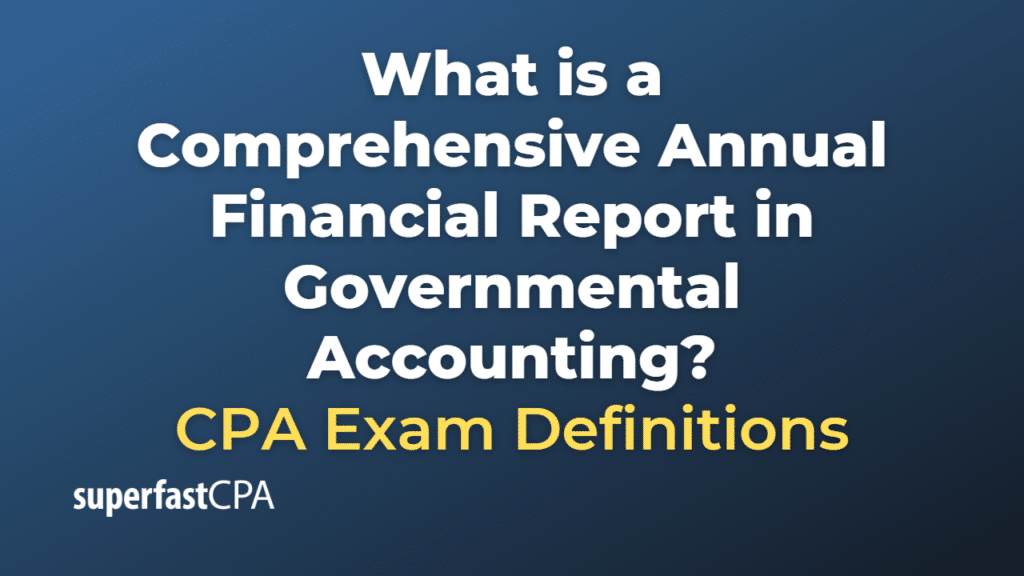Comprehensive Annual Financial Report in Governmental Accounting
A Comprehensive Annual Financial Report (CAFR) is a detailed presentation of a government’s financial condition. It’s prepared by the government’s finance department and is usually audited by an independent auditor to ensure its accuracy and completeness. The report is intended to provide a complete and clear picture of the government’s financial activities and current financial position.
The CAFR is typically divided into three sections:
- Introductory Section: This part provides general information about the government’s structure, services, and environment. It often includes a letter of transmittal (an introductory message from the government’s chief financial officer), an organizational chart, and a list of principal officials.
- Financial Section: This is the heart of the CAFR. It contains the government’s basic financial statements, as well as the independent auditor’s report. The basic financial statements typically include government-wide financial statements that present an overview of the government’s net position and changes in net position, fund financial statements that provide more detailed information about the government’s major funds, and notes to the financial statements that provide additional information and explanations about the financial statements.
- Statistical Section: This section provides additional financial and demographic information, typically presented in multi-year trend tables. This might include data on revenue capacity, debt capacity, demographic and economic information, and operating information.
The CAFR is intended for use by the government’s management, the governing board, investors, creditors, citizens, and other stakeholders who want to understand the government’s financial condition and activities. By providing comprehensive and reliable financial information, the CAFR plays an important role in promoting transparency and accountability in government operations.
Example of a Comprehensive Annual Financial Report in Governmental Accounting
A hypothetical example of what some elements of a Comprehensive Annual Financial Report (CAFR) might look like for a city:
City of Pleasantville Comprehensive Annual Financial Report (CAFR) for the Fiscal Year Ending June 30, 2023
- Introductory Section:
- Letter of Transmittal: The city’s Chief Financial Officer provides an overview of the city’s financial operations for the fiscal year, including major initiatives and changes.
- Organizational Chart: Shows the structure of the city government, including all departments and their hierarchy.
- List of Principal Officials: Lists the Mayor, City Council members, city manager, and heads of key departments.
- Financial Section:
- independent auditor‘s Report: A statement from an independent auditor verifying that the financial report presents the city’s financial condition fairly and accurately.
- Management’s Discussion and Analysis (MD&A): Provides an overview of the city’s financial activities for the year, highlighting significant changes and trends.
- Government-Wide Financial Statements: Shows the city’s overall financial position and changes in financial position. Includes a Statement of Net Position (assets minus liabilities) and a Statement of Activities (revenues and expenses).
- Fund Financial Statements: Gives detailed information about the city’s major funds, such as the General Fund, Capital Projects Fund, and Enterprise Funds. Each fund’s revenues, expenditures, and changes in fund balance are presented.
- Notes to the Financial Statements: Provides additional information and explanations about the financial statements, including accounting policies, details about long-term debt, pension obligations, and more.
- Statistical Section:
- Financial Trends: Shows changes over time in revenues, expenditures, and fund balances.
- Revenue Capacity: Shows the city’s ability to generate its own revenue through taxing and other revenue sources.
- Debt Capacity: Shows the city’s outstanding debt and its ability to issue more debt.
- Demographic and Economic Information: Provides data on the city’s population, income levels, employment, and major employers.
- Operating Information: Provides data on the city’s operations, such as number of government employees, infrastructure statistics, and public safety data.
Keep in mind this is a simplified example. An actual CAFR is a lengthy document that provides a detailed and comprehensive view of a government’s financial condition and operations.













